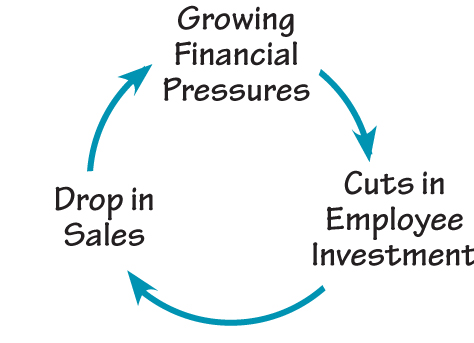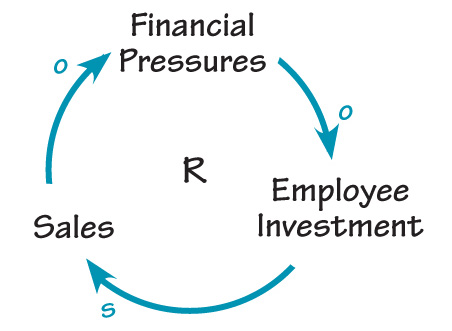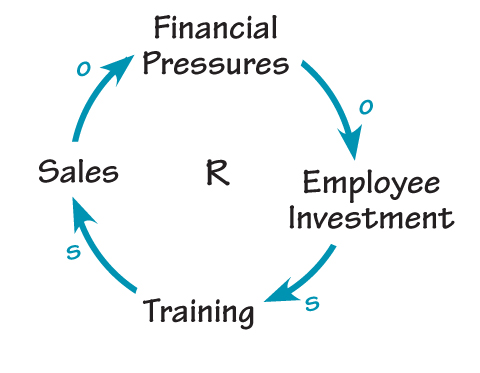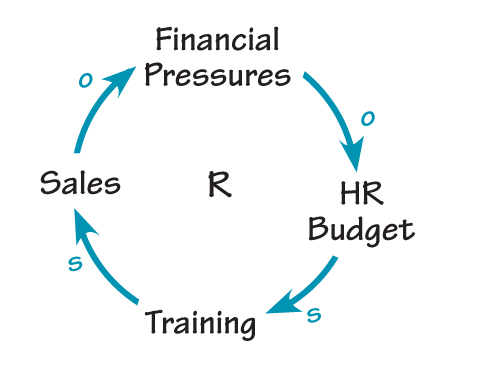 When first beginning to draw a causal loop diagram, don’t spend a lot of time up front trying to select the “perfect” variable name. Instead, focus on telling the story of the problem or issue. For example, suppose you believe that cutbacks in payroll and employee training caused by growing financial pressures will hurt sales over the long run. In a good first diagram of this scenario, you should be able to tell the story simply by reading the variables as you go around the loop.
When first beginning to draw a causal loop diagram, don’t spend a lot of time up front trying to select the “perfect” variable name. Instead, focus on telling the story of the problem or issue. For example, suppose you believe that cutbacks in payroll and employee training caused by growing financial pressures will hurt sales over the long run. In a good first diagram of this scenario, you should be able to tell the story simply by reading the variables as you go around the loop.
 Next, do a quick “clean-up” of the variables by getting rid of “positive” or “negative” qualifiers (e.g. “good,” “bad,” etc.) and stripping away action words (verbs).
Next, do a quick “clean-up” of the variables by getting rid of “positive” or “negative” qualifiers (e.g. “good,” “bad,” etc.) and stripping away action words (verbs).
TIP: If you must choose a variable that is either positive or negative, it is preferable to select the positive sense—for example, it is better to use “growth” rather than “decline” because it is clearer what increasing or decreasing growth would look like.
Placeholder Terms: Peeling the Onion
 In the beginning stages of loop-building, it is often easiest to lump multiple concepts together in a single “placeholder” term while you sketch out the rest of the story. For example, “Employee Investment” represents a broad category of investments, including salary, training, and morale-boosting activities.
In the beginning stages of loop-building, it is often easiest to lump multiple concepts together in a single “placeholder” term while you sketch out the rest of the story. For example, “Employee Investment” represents a broad category of investments, including salary, training, and morale-boosting activities.
At this point, therefore, you may want to ask, “Of the terms that I lumped together, are there key issues that should be pulled out separately?” You may feel that a decrease in your training budget, for example, has a significant effect on your company’s service and sales—so you may decide “Training” should be included as a separate variable. The process of going over the loop again and again to clarify the variables is similar to peeling an onion, revealing deeper layers of issues. How deep you go depends on the specific issue and on what level of understanding you want to gain.
Iterative Process
 After you have worked with the diagram for a while, you can begin to fine-tune the variable names to clarify the picture. For example, you may ask yourself if there is a clearer way to describe the variable “Employee Investment.” Suppose employee investment in your company depends upon the size of the human resources budget—it would therefore be clearer if the term “Employee Investment” were changed to “HR Budget.”
After you have worked with the diagram for a while, you can begin to fine-tune the variable names to clarify the picture. For example, you may ask yourself if there is a clearer way to describe the variable “Employee Investment.” Suppose employee investment in your company depends upon the size of the human resources budget—it would therefore be clearer if the term “Employee Investment” were changed to “HR Budget.”
Expect that your loops will go through many drafts as you continually clarify the story. There are some additional guidelines that may help you select appropriate variable names:
- Use nouns. Avoid verbs, action phrases, or terms that suggest a direction of change, since the “action” in a CLD is conveyed in the arrows. For example, “Decreasing Sales” will cause confusion when you read through the diagram and ask what happens when “Decreasing Sales” increases or decreases. “Sales” is a better choice.
- Variables should be quantities that can vary over time—things that can rise or fall, grow or decline. “Sales Staff Turnover,” for example, is preferable to “Sales Staff Perceptions” (perceptions can change, but they usually do not increase or decrease).
- Is time used in any of the variables? Time itself should generally not be included as a causal agent. When something changes over time, it generally does not change because of the passage of time.
- In drawing CLDs, it is often useful to make a distinction between actual and perceived states. You may find that integrating “actual” or “perceived” into your variable names will help you to clarify your diagrams.
It takes many iterations to create a good diagram, especially if it contains several reinforcing and balancing loops. It is often helpful to show your loops to others to gain different perspectives and enrich your understanding of the dynamics. Another person can help clarify a diagram by pointing out links that are confusing, or ones that may have been missed. Remember, you are not mapping “truth,” but your explicit understanding of how a system operates.
Kellie Wardman is vice president of the Greater Manchester Family YMCA. She also serves as adjunct faculty in creative writing at Southern New Hampshire University. Kellie was publications director of Pegasus Communications. She holds an MFA in creative writing from Emerson College. Go to her blog at http://kelliewardman.com.
